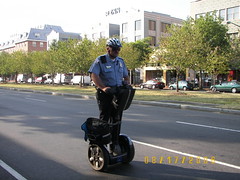For police: 1 segway = 3+ bicycles or = 9 bicycles
 Pennsylvania Avenue SE, Washington, DC.
Pennsylvania Avenue SE, Washington, DC.Thinking about this from an "appropriate technology" standpoint, a police-qualified bicycle costs $1,500 -- in DC. A Segway about $5,000. For some reason, in Worcester, Massachusetts, police bikes cost $500. See, "Worcester revives bike patrols," from the Worcester Telegram & Gazette. From the article:
Having officers on the streets, but out of cruisers, gives people better opportunities to interact with them, Chief Gemme and the officers said. A horse patrol is slated to be on the city streets next year, also operating through the community impact division.
“We’re more approachable than if we were in a car,” Officer Belsito said outside the Dunkin’ Donuts on Shrewsbury Street. “You’re more apt to stop and talk to people. People will approach us more often on the bike.”
That’s one of the differences. Bicycles can be maneuvered through alleyways and are quiet. Bike officers need to be physically fit, Chief Gemme pointed out. The pedals on a cruiser and a bicycle are much different.
Index Keywords: bicycle; public-safety



0 Comments:
Post a Comment
<< Home